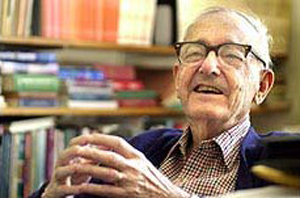Herbert Simon
 Carnegie Mellon University Professor Herbert A. Simon (1916-2001) was known for his work in cognitive psychology and computer science. Dr. Simon was widely considered to be a founder of the field of artificial intelligence. He made extensive use of the computer as tool for both simulating human thinking and augmenting it with artificial intelligence. The thread of continuity through all of his work was his interest in human decision-making and problem solving processes and the implications of these processes for social institutions. Not only did his research impact psychology and computer science, it followed into administration and economics.
Carnegie Mellon University Professor Herbert A. Simon (1916-2001) was known for his work in cognitive psychology and computer science. Dr. Simon was widely considered to be a founder of the field of artificial intelligence. He made extensive use of the computer as tool for both simulating human thinking and augmenting it with artificial intelligence. The thread of continuity through all of his work was his interest in human decision-making and problem solving processes and the implications of these processes for social institutions. Not only did his research impact psychology and computer science, it followed into administration and economics.
Artificial Intelligence
In 1955, he, Newell and programmer J.C. Shaw creating Logic Theorist, a computer program that could discover proofs of geometric theorems. It was the first computer program capable of thinking and marked the beginning of what would become known as artificial intelligence.
Human Cognition
He and Newell also developed a theory that the human mind manipulates symbols in much the same way that a computer does. They were at the core of the cognitive revolution in the 1960s, when psychologists began to use computers to study how the thinking process works.
Most notably, his quest to understand decision-making led him to develop his economic theory of “bounded rationality,” for which he was awarded the 1978 Nobel in economics.
Awards
- ACM A.M. Turing Award (1975) – Contributions to Artificial Intelligence
- Nobel Prize in Economic Science (1978) – Decision Making “Bound Rationality”
- U.S. Medal of Science (1986) – Contributions to problem solving behavior and decision making Notable Publications
- Administrative Behavior: A Study of the Decision Making Processes in Administrative Organization (1947)
- Organizations (1958) – with James G. March
- The Sciences of the Artificial (1969)
Physical Symbol System:
- Human thinking = symbol manipulation
- Intelligence resides in physical symbol systems
- Symbol systems are collections of patterns and processes
Heuristic Search:
- Symbol systems solve problems by searching
- The search is sequential
- Extracting information from a problem domain to guide their search
Related Thinkers
Over his career, Simon produces such a wide body or work publishing nearly a thousand articles extending from computer science to cognitive science and economics. Many of his contributors to the field of HCI have influenced many of the prominent thinkers and many have also referenced his work.
- Lucy Suchman also references Simon’s work in Artificial Intelligence in her publication Robot Visions.
- Terry Winograd references Simons work about Artificial Intelligence in his work, Thinking Machines.
- Bruno Latour’s philosophy of design, “Five Advantages of Design” was influenced by Simon’s publication Design Thinking.
Text by Jarman H, Yuetian F, Sarah W and Dan S.